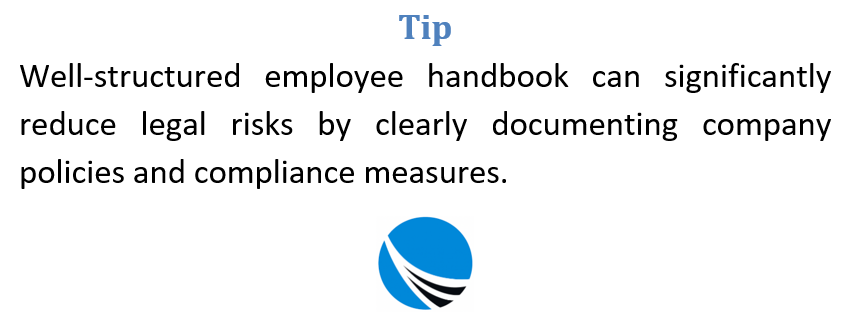A successful business requires more than just a good product or service—it depends heavily on effective internal communication. One of the most reliable tools for establishing this communication is the employee handbook. It’s not just a formality but a strategic document that connects your staff with the core of your operations, laying out the principles, processes, and expectations that shape the work environment.
At its essence, an employee handbook functions as a practical reference guide for your team. It informs them about workplace norms, explains policies clearly, and provides a shared understanding of roles, responsibilities, and rights. This consistency helps ensure that everyone is aligned, regardless of department or seniority level.
By putting everything in writing, the handbook becomes a tool that reduces ambiguity, limits disputes, and reinforces a sense of belonging and professionalism.

Why Every Company Should Have One
Regardless of your business size, having an employee handbook is not just helpful—it’s essential. For small startups, it creates structure in a growing workforce. For large organizations, it maintains order across diverse teams.
One major reason to adopt a handbook is legal protection. It outlines compliance with labor laws, establishes procedures for handling grievances, and acts as evidence that employees were informed of expectations. This is especially important if workplace issues escalate into formal complaints or legal action.
Beyond legal safeguards, a handbook builds trust. When employees understand how decisions are made—from hiring practices to promotions—they’re more likely to feel secure and valued. It also speeds up onboarding by giving new hires immediate access to what they need to know to thrive in your company.
Finally, a well-crafted handbook fosters a healthy workplace culture by reinforcing company values and showing your commitment to fairness and transparency.
Essential Topics to Cover in an Employee Handbook
For the handbook to be useful, it should offer a full picture of your workplace operations. While the specifics will vary depending on your industry, some components are universal.

Company Philosophy and Objectives
Kick off the handbook by describing your company’s mission and values. Explain the principles that guide your decisions, and clarify how employees contribute to achieving business goals. This helps staff identify with your vision and feel connected to the broader purpose behind their daily work.
Behavioral Expectations and Conduct
Every organization needs standards of behavior to maintain a respectful and efficient work environment. This section should clearly define appropriate workplace behavior—covering things like punctuality, communication etiquette, use of company resources, and dress expectations.
This portion should also outline what types of conduct are considered unacceptable, such as workplace bullying, unethical behavior, or misuse of confidential information. Setting these boundaries from the beginning prevents misunderstandings and maintains workplace harmony.
Operational Policies and Procedures
This section focuses on the rules that keep your business running day-to-day. Include policies related to attendance, time tracking, health and safety, cybersecurity, and remote work (if applicable). Describe how to report incidents, request accommodations, or seek assistance with tech tools.
Having clear, standardized policies ensures that everyone knows what’s expected and how to handle routine issues without constant supervision.
Compensation and Professional Development
Although it’s not necessary to list specific salaries, the handbook should describe how pay is determined. Mention wage structures, pay periods, overtime procedures, performance incentives, and how raises are decided.
You should also include a section on learning and advancement. Outline training opportunities, internal mobility policies, and mentorship programs if available. When employees see a clear path forward, they’re more likely to remain engaged and stay long term.
Employee Benefits
Outline the key perks your company offers—whether that’s health insurance, paid parental leave, wellness allowances, or discounted gym memberships. Be specific about who qualifies and when coverage starts.
Benefits aren’t just perks; they reflect your commitment to employee welfare. Detailing them in the handbook ensures transparency and boosts morale.
Leave Entitlements and Public Holidays
It’s important to be specific about time off. Describe your policies for vacation, sick leave, bereavement leave, maternity and paternity leave, and how holidays are observed.
Make sure employees know how much leave they’re entitled to, how to request it, and who has final approval. Clear rules help teams plan better and avoid unnecessary disruptions to productivity.

Equal Opportunity and Anti-Discrimination
Your handbook must include a zero-tolerance statement against harassment, discrimination, and retaliation. Emphasize your company’s commitment to equity and provide steps for employees to report incidents confidentially.
Having this policy in writing signals your commitment to an inclusive workplace and gives employees the assurance that complaints will be handled professionally and fairly.
Exiting the Organization
Whether someone resigns or is terminated, the exit process should be smooth and respectful. Explain what steps employees must follow when leaving the company, such as giving notice, completing an exit interview, and returning company equipment.
This section helps eliminate confusion and preserves a positive relationship even as employees transition out of the organization.
Acknowledgment of Receipt
To conclude the handbook, include a simple acknowledgment form. Ask employees to sign it, confirming that they’ve read and understood the contents. Keep this form in their personnel file. It reinforces accountability and protects your business in the event of future disputes.
Steps to Craft a Strong Employee Handbook
Writing a handbook doesn’t have to be daunting. Follow a structured approach to build it effectively.
Step 1: Collect Internal Materials
Start by gathering all existing policies, compliance documents, safety protocols, and internal communication guidelines. Determine what’s currently missing and what needs clarification or updating.
Step 2: Map Out a Logical Structure
Organize the handbook into sections that flow naturally—from big-picture company values to detailed workplace rules. Make sure each section addresses a specific topic without overlap.
Step 3: Write in Clear, Accessible Language
Avoid using jargon or overly formal language. Write as if you’re speaking directly to the reader. This will help ensure everyone—from interns to senior staff—can easily understand the content.
Step 4: Use Examples and Scenarios
Bring your policies to life by including relatable examples. For instance, outline how to properly apply for leave or what steps to take if someone experiences harassment. Realistic scenarios help staff visualize the application of policies.
Step 5: Involve Stakeholders in the Review
Once you have a draft, ask team leads, department heads, and HR professionals to review it. They may spot inconsistencies or areas where clarification is needed.
Step 6: Consult Legal Experts
Employment law is complex and varies by region. Always get a legal professional to review the handbook for compliance. This step is critical in protecting your business from unintentional violations.
Step 7: Format for Easy Access
Design the document with readability in mind. Use bullet points, headers, and tables of contents. Consider creating a digital version that’s searchable and accessible across devices.
Step 8: Plan for Periodic Updates
Policies change. Whether due to internal shifts or legal updates, your handbook should be a living document. Schedule annual reviews to keep it accurate and up to date.
Leveraging Handbook Templates and Examples
Plenty of digital platforms offer templates that simplify handbook creation. These samples can serve as a helpful guide, especially for small business owners new to HR management.
However, treat templates as starting points—not final drafts. Tailor each section to reflect your company’s specific operations, values, and legal obligations. Also, strip out any legalese that may confuse employees. Simplicity, not complexity, should guide your tone.
Before adopting any template, verify that it meets local labor laws and that it doesn’t include outdated or irrelevant content.
Implementing Your Handbook Effectively
Once your handbook is finalized, how you introduce it is just as important as its content. Don’t simply email it or hand out copies without explanation.
Instead, set up a formal orientation session. Use this time to explain why the handbook exists, what it includes, and how staff should use it. Allow time for questions and clarify any confusion. Providing both digital and physical copies ensures that employees can access the information in the format that suits them best.
Make sure everyone knows the handbook will be updated regularly, and they’ll be notified when major changes occur.
Using Digital Tools to Streamline the Process
Modern technology can greatly ease the process of creating and managing employee handbooks. There are tools designed to help businesses write, edit, and distribute policies with built-in templates and automation features.
Some platforms integrate with HR software, allowing real-time updates, digital signatures, and version tracking. This not only saves time but ensures consistency in documentation across teams.
These tools also make it easier to personalize the handbook for different departments while keeping the format uniform. They’re especially useful for remote or distributed teams who need instant access to company information.
Conclusion: Building a Better Workplace Through Clarity
An employee handbook is far more than a collection of policies. It’s a vital communication tool that supports your team, defines your culture, and helps your business operate smoothly.
When done right, it empowers employees with knowledge, reduces conflicts, and builds a foundation of trust. Don’t view it as just another HR task—see it as an investment in the strength and unity of your organization.
Take the time to craft a handbook that reflects your values, supports your goals, and helps every employee feel informed, valued, and included.

